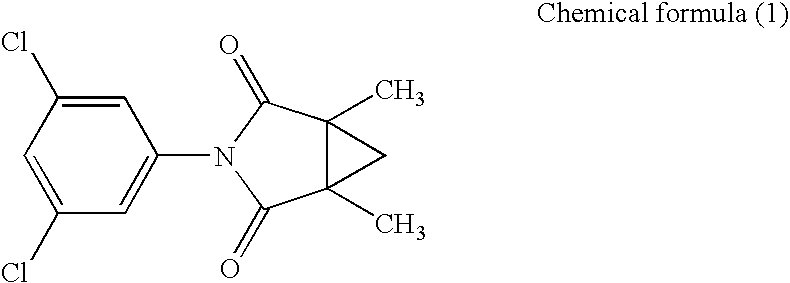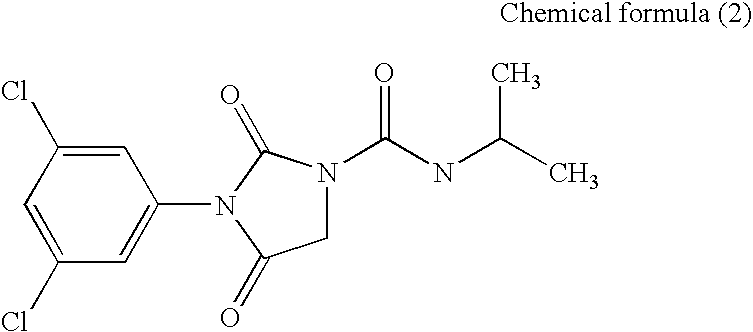Transformed cell with enhanced sensitivity to antifungal compound and use thereof
a technology of enhanced sensitivity and transformed cells, applied in the direction of enzymology, enzymology, organic chemistry, etc., to achieve the effect of enhancing sensitivity to an antifungal compound
- Summary
- Abstract
- Description
- Claims
- Application Information
AI Technical Summary
Benefits of technology
Problems solved by technology
Method used
Image
Examples
example 1
Isolation of Botryotinia fuckeliana BcOS-1 Gene
[0172]Total RNA was prepared from Botryotinia fuckeliana. 100 mg of a hypha of Botryotinia fuckeliana strain Bc-16 grown on a potato dextrose agar medium (PDA medium manufactured by NISSUI Pharmaceutical Co., Ltd.) was scratched off, and this was ground in liquid nitrogen using a mortar and a pestle. A RNA was prepared from frozen ground powder using RNeasy Plant Mini Kit (QIAGEN). A frozen ground powder together with liquid nitrogen was transferred to a 50 ml sample tube and, after liquid nitrogen was all volatilized, a solution obtained by adding 10 μL of mercaptoethanol per 1 ml of a buffer RLC attached to kit was added, followed by stirring. Further, ground powder was well dispersed by a few of pipettings, and was incubated at 56° C. for 3 minutes. Thereafter, the solution containing ground powder was supplied to QIAshredder spin column attached to the kit, and centrifuged at 8,000×g for 2 minutes. The filtration supernatant was tra...
example 2
Construction of Expression Plasmid of Botryotinia fuckeliana BcOS-1 Gene and Preparation of Transformed Budding Yeast
[0175]BcOS-1 DNA was cloned into a shuttle vector p415ADH (ATCC87312) replicable in yeast and Escherichia coli. About 4 kb of the aforementioned DNA (BcOS-1 DNA) was purified from the PCR reaction solution prepared in Example 1 using QIAquick PCR Purification Kit (QIAGEN) according to the attached manual. About 4 kb of the purified DNA (BcOS-1 DNA) was digested with restriction enzymes SpeI and PstI and, on the other hand, the shuttle vector p415ADH was also digested with restriction enzymes SpeI and PstI and, thereafter, each of which was separated by 0.8% agarose gel electrophoresis, and a part of the gel containing a desired DNA was excised. The BcOS-1 DNA digested with SpeI and PstI and the shuttle vector digested with SpeI and PstI were recovered from the gel using QiAquick Gel Extraction Kit (QIAGEN) according to the attached manual. The aforementioned BcOS-1 DN...
example 3
Antifungal Compound Sensitivity Test of Transformed Budding Yeast TM182-BcOS1
[0177]The transformed budding yeast AH22-BcOS1 prepared in Example 2 was cultured while shaking at 30° C. for 18 hours in a Glu-Leu medium. As a control, the AH22 strain was similarly cultured while shaking at 30° C. for 18 hours in a Glu medium. The absorbance at 600 nm of each of the grown transformed budding yeasts in a cell suspension was measured, and a cell suspension diluted with sterilized distilled water to the absorbance of 0.1 was prepared. Further, a cell suspension in which the aforementioned cell suspension of the transformed budding yeast AH22-BcOS1 was diluted 200-fold with a Glu-Leu medium, and a cell suspension in which the aforementioned cell suspension of the AH22 strain was diluted 200-fold with a Glu medium were prepared. A solution in which each of Compounds (1) to (3) was dissolved in dimethylsulfoxide (DMSO) to the concentration of 60 ppm, a solution in which each of Compounds (4) a...
PUM
| Property | Measurement | Unit |
|---|---|---|
| temperature | aaaaa | aaaaa |
| temperature | aaaaa | aaaaa |
| temperature | aaaaa | aaaaa |
Abstract
Description
Claims
Application Information
 Login to View More
Login to View More - R&D
- Intellectual Property
- Life Sciences
- Materials
- Tech Scout
- Unparalleled Data Quality
- Higher Quality Content
- 60% Fewer Hallucinations
Browse by: Latest US Patents, China's latest patents, Technical Efficacy Thesaurus, Application Domain, Technology Topic, Popular Technical Reports.
© 2025 PatSnap. All rights reserved.Legal|Privacy policy|Modern Slavery Act Transparency Statement|Sitemap|About US| Contact US: help@patsnap.com



